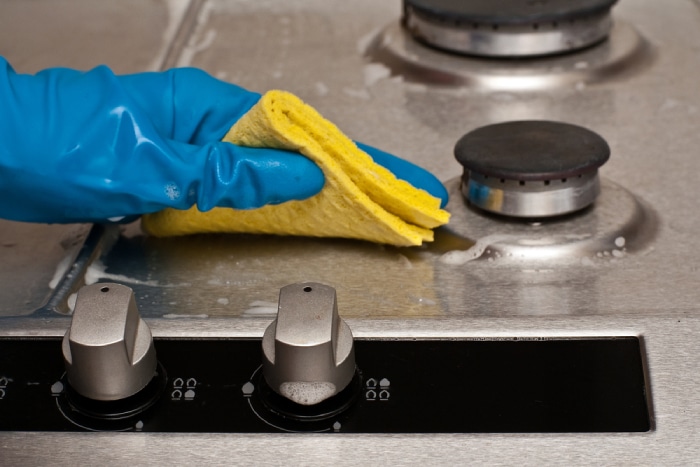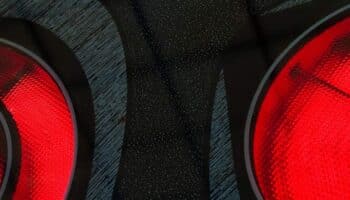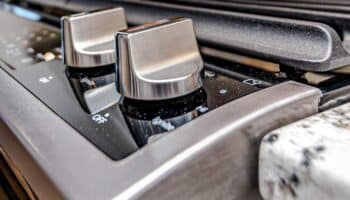Stuck with an orange flame on your gas stove? You’re not alone.
An orange flame on your gas stove signals a few things – but unfortunately none of them are good!
An orange flame on a gas stove can be due to a clogged burner, food spillage, increased humidity, or even incorrect installation.
In this article, we’ve explored why an orange flame might be happening, with some quick solutions to help you fix it.
If that sounds good, then let’s dive in.

Chemistry in the Kitchen
Let’s start with looking at what’s causing that orange flame. Some of that chemistry you learned in a school laboratory happens right in your kitchen. Before we dive into why your gas stove has an orange flame, it’s worth understanding what’s happening with the flame..
Whatever you call natural gas belongs to a group of compounds known as hydrocarbons, resulting from chemical reactions between carbon and hydrogen. Fossil fuels, such as diesel, petrol, coal, and methane, belong to the hydrocarbon category. Most American homes use natural gas, called methane, in their home heating systems, such as gas stoves and home furnaces.
Burning is a chemical process where a hydrocarbon reacts with oxygen to produce carbon dioxide and water. Here is a simplified chemical process:
CH4 + 2O2 → CO2 + 2H2O
The above chemical process represents an ideal situation where the correct oxygen balance perfectly reacts with the right methane volume to produce carbon dioxide and water vapor.
Orange Flame
You should always keep in mind that the color of the flame is an indicator of the amount of heat produced by combustion. The proper mixture of natural gas and oxygen will make a hissing blue flame; thus, blue indicates the proper stove function. However, an improper combination will result in an orange flame which you now know is dangerous.
The Risk of Incomplete Combustion
The improper mixture of fuel and oxygen usually results in incomplete combustion, which produces carbon, carbon monoxide, and water instead of carbon dioxide and water during proper combustion. The following equation may help you understand better;
hydrocarbon + oxygen-> carbon + carbon monoxide + water.
Incomplete methane combustion can also produce a mixture of other partially oxidized products such as formaldehyde, methanol, and formic acid.
If your gas stove is producing a hissing blue flame, proper combustion is taking place and consequently the production of normal carbon monoxide levels. However, orange flames mean an increased level of poisonous CO gas, which is not safe for your health, utensils, and home décor.

If left unattended, carbon monoxide can be a silent killer when ventilation is poor. This is because of the colorless and odorless qualities that enable it to kill when least expected. It would help if you always remembered that gas stoves lack a vent and should not be used to warm your home. Surprisingly, even the supposedly healthy blue flame also produces some CO amounts, which are very dangerous if they accumulate in poorly ventilated places.
Watch out for the following signs of carbon monoxide poisoning;
- Dizziness
- Drowsiness
- Fatigue
- Convulsions
- Confusion
- Fainting
- Coma
- Heightened irritability
- General achiness and weakness
- Impaired judgment
- Shock
- Nausea and vomiting
- Abnormal heartbeat
- Low blood pressure
- Hyperactivity
- Muscle weakness
- Breathing problems (rapid breathing, no breathing, and shortness of breath)
- Sudden chest pains for angina patients
Incomplete combustion produces soot which emits an orange flame when you light the gas stove. Soot is a health hazard because it can cause and increase respiratory allergies when inhaled. Soot produces a sticky black film on the utensils and pots, making them harder to clean normally. And it will ruin your home décor, say your white ceiling boards and cupboards.
Causes of Fuel-Oxygen Mixture Imbalance
There are several causes of improper combustion that produce the orange flame on your gas stove.
Clogged Burner Orifices
You should remember that incomplete combustion produces soot that sticks to the burner orifices and any other surfaces to understand this point. Continued combustion of soot cakes the gas stove burner orifices which inhibit the proper flow of air. The radiant orange glow emanates from burning soot.
Additionally, the soot blocks some of the gas, creating air pockets and cooler orange flames. Consequently, only a tiny percentage of natural gas burns to produce the hot flame while wasting the rest. Gas wastage can increase your bills by a considerable margin.
Increased Humidity
Increased humidity can change the gas stove’s flame from blue to yellow, especially if the stove shares a room with a humidifier.
Wrong Orifices
Carbon fuels used in gas stoves have different air and fuel mixture ratios for complete combustion to occur. For example, natural gas will require a different amount of air compared to liquid propane. If the burner is new and you observe an orange flame, it means that either the manufacturer installed the air shutter at the wrong place or the burner you bought is incompatible with your gas stove.
Food spillage
Food and drink may spill over the pot and onto the burner when left unattended. You can all identify with milk spilling when you least expect it! Burning food particles may produce a radiant yellow flame on your gas stove burner.
How to Fix An Orange Flame On Your Gas Stove
Don’t be alarmed yet by the orange flame because it isn’t a hazard by itself and will only become a threat when not fixed. Here is how to fix an orange flame.
Clean Burners
Due to incomplete combustion, soot piles up and blocks the small holes in the gas stove burner, which necessitates proper cleaning. Ensure that you clean the whole gas burner properly, taking care not to leave clogging in the holes or the igniter.

Clean the burners properly to get rid of any debris or food particles. Cooking spillage such as grease, milk, and other food traces burns on the gas stove burner to produce the yellow color inside the otherwise blue flame.
Cleaning and maintenance involve tampering with the components of the gas stove, so remember to restore every little piece to its rightful place because the wrong placement of components can also alter the flame color.
Proper Orifices
Natural fuels do not require the same air-fuel mixture ratio. For example, liquid propane needs more air for combustion than natural gas; therefore, ensure that your burner has orifices suited to natural gas. Additionally, adjust the brass aperture and change the valve that controls gas pressure.
More air, please
The flame on the gas stove burner may change from blue to yellow due to an unbalanced air to fuel ratio, probably because of poor ventilation. Poor airflow inside the kitchen may limit the amount of air accessible to the stove, leading to incomplete combustion and the danger of suffocation due to competition for oxygen between the stove and people. It would be best if you opened all the air inlets, such as doors and windows. If the problem is with the burner, place the air shutter to allow a sufficient airflow.
Humidifiers
Humidity is good for your health because it keeps your skin glowing and alleviates sinus infection symptoms. However, it is not advisable to use the humidifier alongside a natural gas stove because it interferes with proper combustion, which results in yellow flames. If you run a humidifier inside the room that houses the gas stove burner, say the kitchen, turn it off until you are using the stove.
Dismantling and reassembling
This method has worked in some cases, so it is worth a trial. Begin with removing the stove’s top grate and lifting the top to access the burner piping. The air shutters are usually located behind the gas valves, a plate or tube covering the burner’s air vent. Use a screwdriver to loosen the shutter. Light the burner and slowly regulate the air shutters until you observe a full blue flame. Lastly, tighten the screws, switch off the burner, and replace the stovetop and top grates.
Still Stuck With An Orange Flame?
If these tips haven’t helped – don’t worry. There may be other quick fixes you can try.
We’re fortunate enough to have a lot of readers on our website, but unfortunately I can’t answer everyone’s questions personally. To help, we’ve teamed up with JustAnswer to connect you to a qualified Appliance expert.
You can connect with an appliance expert below, who will help you solve your specific issue. They do charge a small trial fee, so just remember to cancel the trial once you get your stove working normally again.
Bottom Line
While a yellow flame signals improper gas combustion, it will only become a safety threat if you fail to take the proper cleaning and maintenance steps. The yellow flame is caused by several things, including piling up of soot in the burner portholes, insufficient air supply, burning of cooking spillovers, installation of wrong orifices, and excessive humidity.
The orange flame is a red flag, and you need to clean the gas stove, which is an excellent DIY project. Remember to unclog the orifices, clean the burner of any debris, switch off the humidifier, regulate the air shatter and dismantle the whole stove before reassembling. Don’t forget to call in an HVAC technician if you aren’t confident in your stove maintenance skills.







